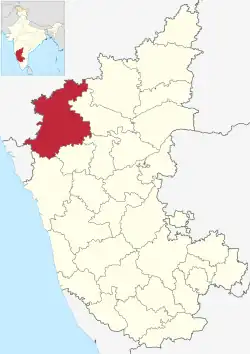Gavali, Karnataka
Gavali (also Gawali) is a small village located in the Belgaum district, Karnataka state in India, southwest of the city of Belgaum. The village is surrounded by forests, waterways and falls, which are subject to illegal mining, removal of medicinal plants and deforestation.
Gavali
Gawali | |
|---|---|
village | |
| Country | |
| State | Karnataka |
| District | Belgaum |
| Government | |
| • Type | Panchayat raj |
| Population (2011) | |
| • Total | 373 (94 households) |
| Languages | |
| • Official | Kannada |
| Time zone | UTC+5:30 (IST) |
| ISO 3166 code | IN-KA |
| Nearest city | Belgaum |

A proposed Mandovi River (Mahadayi River) water diversion and hydroelectric power plant project would result in the submersion of some or all of Gavali.
Geography
Sitting on a large plateau, the village is about 810 metres (2,660 ft) above sea level, surrounded by forests of the Western Ghats, one of the 18 global ecological hotspots, known for its dense forests, medicinal plants and trees, agricultural lands and mining resources that are at risk due to illegal mining, smuggling of medicinal plants and trees and deforestation. Over 500 acres of farm land was bought from Gavali village farmers by one person.[1][2]
Gavali village is one of the identified Medicinal Plants Conservation Areas requiring eco-restoration.[3]
Between the village of Gavali and Chapoli, the Mandovi River that flows to the beautiful 200 metres (660 ft) Vajrapoha Falls (also Vajrapoya waterfalls),[4] best seen after the monsoon season (June–October).[5] The falls are about 1.5 hours southwest of the city of Belgaum.[6]
The Mandovi River (also called the Mahadayi River) is fed by streams near the villages of Gavali, Hemmadaga, Jamboti, Kankumbi, and Talawade villages. Lying in the mountainous Western Ghats (also called Sahyadris), the region may receive up to 3,800 to 5,700 millimetres (150 to 220 in) of rainfall per year. During the summer months (March–May) the stream and river water levels can become low, resulting in water shortages.[5][7] The Gavali village temple area is thought by some to be the birthplace of the Mandovi river.[1][8]
Proposed Mandovi River Dam project
A proposed Mandovi River (also Mahadayi River) water diversion and hydroelectric power project would result in submersion of 1,000 acres of agricultural land and 4,300 acres of forest. Some or all of Gavali would be submerged with other neighbouring towns. Under the project,
- the main Kotni dam would divert water above Khanapur and produce power
- five additional dams would be built to produce hydroelectric power
- six more dams would be built to divert water to the Malaprabha River.[9][10]
The governmental plan, on hold for various reasons, to build the Kotni dam has been recently revived. While geologists determine whether the area can support a dam, Paryavarni, an environmental group, and the Goa government seek to stop the dam from being built and protect the regions delicate environment.[11]
Languages
Languages spoken in the area are Marathi, Kannada and in towns English is commonly spoken.[5]
Education
Baburao Thakur, a Gaud Saraswat Brahmin (GSB), was a noted journalist, freedom fighter and social worker who led the establishment of the Belgaum Jilha Prathamik Shikshan Samiti on 1 October 1937. The Samiti established its second primary school in the remote village of Gavali and 206 schools were established and managed by the Samiti by 1939. Although the teachers faced housing issues, poor sanitation, inadequate water supply and low wages, the schools became a model for the Government of Bombay (now Mumbai). In the course of the work in the remote communities, the Samiti developed adult education courses, built roads, advised on agricultural issues and developed programs for sanitation — all of which raised the local standard of living.[12]
Prehistoric rock art
Rock engravings are found at Gavali, Udupi made during the megalithic period of a side view of a humped bull.[13]
References
- Kasbekar, Durgesh; Mhaskar, Major; Madhav, Vishweshwar; Dongre, Vrushal. Bhimgad a forest worth saving. Bhimgad site. Retrieved 2011-11-11.
- The Hindu Staff Correspondent Rich ecology of Western Ghats is being neglected. The Hindu, Online edition of India's National Newspaper. 20 January 2007. Retrieved 2011-11-11.
- Sri Anant Hegde Ashisar, Chairman. Major Interim Recommendations of Western GHats Task Force Archived 31 March 2012 at the Wayback Machine Western Ghats Task Force Dept. of Forest & Environment. Government of Karnataka. 28 September 2010. Retrieved 2011-11-11.
- Kerkar, Rajendra P. Vajrapoya, a gorgeous waterfall in the Western ghats. The Times of India. Bennett, Coleman & Co. Ltd. 30 April 2009. Retrieved 2011-11-11.
- The Hermitage Guest House in the Western Ghats Archived 5 November 2011 at the Wayback Machine The Hermitage Guest House. Retrieved 2011-11-12.
- Directions from Belgaum, Karnataka, India to Vajrapoha Water Falls, Karnataka, India Google maps. Retrieved 2011-11-11.
- Mondovi/Mahadayi River, Karnataka. Archived 4 November 2011 at the Wayback Machine Tour Karnataka. Retrieved 2011-11-11.
- Pai, Mohan. Mahadayi/Mandovi River Valley - Part IV. Mahadayi/Mandovi River Valley. 5 August 2008. Retrieved 2011-11-11.
- Pai, Mohan. Threats to the Valley Mahadayi/Mandovi River Valley - Part II. Mahadayi/Mandovi River Valley. 12 January 2009. Retrieved 2011-11-11.
- Pai, Mohan. Extracts from upcoming "Mahadayi/Mandovi River Valley" book. Archived 2012-04-02 at the Wayback Machine Retrieved 2011-11-11.
- Bijapur, Naushad. Greens oppose dam in Ghats. Deccan Chronicle. 28 May 2011. Retrieved 2011-11-11.
- Founder Members of Belgaum Jilha Prathamik Shikshan Samiti, Belgaum Belgaum Jilha Prathamik Shikshan Samiti: Marathi Teachers Training Institute. Retrieved 2011-11-11.
- Making history : Karnataka's people and their past, vol. 1 Volume 1: Stone Age to Mercantilism (40,000 BP-240 BC). CSCS. Retrieved 2011-11-11.
External links
- Map of Gavali and Belgaum District area.
- Belgaum district site
- The Mahaday (Mandovi) River in Karnataka, lovely area photos, including the Gavali temple and Vajrapoha Falls.